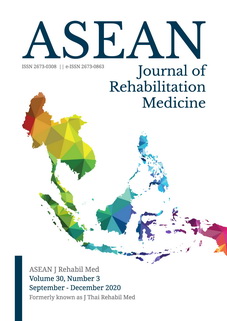Relationship between Service Provision and the Use of Trans-tibial Prostheses: a Study from Sirindhorn School of Prosthetics and Orthotics in Thailand
Keywords:
leg prosthesis, artificial limb, amputeesAbstract
Objectives: To study servicing factors related to the use of trans-tibial prosthesis.
Study design: Retrospective study.
Setting: Sirindhorn School of Prosthetics and Orthotics, Faculty of Medicine Siriraj Hospital
Subjects: Amputees who received trans-tibial prostheses and completed follow-up during May 2019 to February 2020
Methods: The data collection was done by reviewing the participants’ medical records and follow-up forms. The data of the participants and of the most recent prosthesis which had been used for at least one month was retrieved. The participants were divided into daily-user and non-daily-user groups.
Results: There were 44 participants. The median age was 56 years. The most common cause of amputation was trauma (40.9%). Most of them had underlying disease (68.2%) and had problems after receiving the prosthesis (68.2%). Twenty-nine participants (65.9%) used the prosthesis every day. Comparing between the two groups, statistically significant difference was found for receiving the prosthesis from less experienced prosthetists and less time from casting to fitting day. (p = 0.026 and 0.006, respectively). The only factor affecting the every-day use of prosthesis was the time from casting to fitting day (odd ratio = 5.4, 95% CI 1.3-22.7). The cut-off duration for casting to fitting day was 21 days.
Conclusion: Most of the amputees who received the tran-stibial prosthesis from Sirindhorn School of Prosthetics and Orthotics used the prosthesis every day. The only factor affecting the everyday use of prosthesis is the time from casting to fitting day. The cut-off duration for casting to fitting day was 21 days.
Keywords: leg prosthesis, artificial limb, amputees
References
National Statistical Office [internet]. Bangkok: National Statistical Office, Thailand. 2012 - [cited 2020 May 28]. Available from: http://www.nso.go.th/sites/2014/Pages/%E0%B8%AA%E0%B8%B3%E0%B8%A3%E0%B8%A7%E0%B8%88/%E0%B8%94%E0%B9%89%E0%B8%B2%E0%B8%99%E0%B8%AA%E0%B8%B1%E0%B8%87%E0%B8%84%E0%B8%A1/%E0%B8%AA%E0%B8%A7%E0%B8%B1%E0%B8%AA%E0%B8%94%E0%B8%B4%E0%B8%81%E0%B8%B2%E0%B8%A3%E0%B8%AA%E0%B8%B1%E0%B8%87%E0%B8%84%E0%B8%A1/%E0%B8%84%E0%B8%A7%E0%B8%B2%E0%B8%A1%E0%B8%9E%E0%B8%B4%E0%B8%81%E0%B8%B2%E0%B8%A3.aspx.
Hordacre BG, Stevermuer T, Simmonds F, Crotty M, Eagar K. Lower-limb amputee rehabilitation in Australia: analysis of a national data set 2004-10. Aus Health Rev. 2013;37:41-7.
Van Brakel W, Poetsma PA, Tam PT, Verhoeff T. User satisfaction and use of prostheses in ICRC’S special fund for the disabled project in Vietnam. Asia Pacific Disabil. 2010;21:70-91.
National Statistical Office [internet]. Bangkok: National Statistical Office, Thailand. 2017. [cited 2020 May 28]. Available from: http://www.nso.go.th/sites/2014/Pages/%E0%B8%AA%E0%B8%B3%E0%B8%A3%E0%B8%A7%E0%B8%88/%E0%B8%94%E0%B9%89%E0%B8%B2%E0%B8%99%E0%B8%AA%E0%B8%B1%E0%B8%87%E0%B8%84%E0%B8%A1/%E0%B8%AA%E0%B8%A7%E0%B8%B1%E0%B8%AA%E0%B8%94%E0%B8%B4%E0%B8%81%E0%B8%B2%E0%B8%A3%E0%B8%AA%E0%B8%B1%E0%B8%87%E0%B8%84%E0%B8%A1/%E0%B8%84%E0%B8%A7%E0%B8%B2%E0%B8%A1%E0%B8%9E%E0%B8%B4%E0%B8%81%E0%B8%B2%E0%B8%A3.aspx.
Jensen JS, Nilsen R, Zeffer J. Quality benchmark for trans-tibial prostheses in low-income countries. Prosthet Orthot Int. 2005;29: 53-8.
Pohjolainen T, Alaranta H. Predictive factors of functional ability after lower-limb amputation. Ann Chir Gynaecol. 1991;80:36-9.
Pumpitakkul K SC, Sirisabya P. The follow up study in usage of lower limb prosthesis in Police General Hospital 1999. J Thai Rehabil. 2000;10:7.
Thirapatarapong W, Dajpratham P. Prosthetic usage among the Thai lower limb amputees. Siriraj Med J. 2009;61:185-8.
Anannub K. Study the duration of producing lower extremity prostheses and the satisfaction of patients. Med J Srisaket Surin Buriram Hosp. 2019;34:303-11.
Boone DA, Kobayashi T, Chou TG, Arabian AK, Coleman KL, Orendurff MS, et al. Perception of socket alignment perturbations in amputees with transtibial prostheses. J Rehabil Res Dev. 2012;49:843-53.
Chen CWJ, Heim W, Fairley K, Clement RJ, Biddiss E, Torres-Moreno R, et al. Evaluation of an instrument-assisted dynamic prosthetic alignment technique for individuals with transtibial amputation. Prosthet Orthot Int. 2015;40:475-83.
Polliack AA, Craig DD, Sieh RC, Landsberger S, McNeal DR. Laboratory and clinical tests of a prototype pressure sensor for clincial assessment of prosthetic socket fit. Prosthet Orthot Int. 2002;26:23-34.
Jensen JS, Raab W, Fisk J, Hartz C, Saldana A, Harte C. Quality of polypropylene sockets for trans-tibial p in low-income countries. Prosthet Orthot Int. 2006;30:45-59.
Colombo G, Filippi S, Rizzi C, Rotini F. A new design paradigm for the development of custom-fit soft sockets for lower limb prostheses. Comput Ind. 2010;61:513-23.
Hanspal RS, Fisher K, Nieveen R. Prosthetic socket fit comfort score. Disabil Rehabil. 2003;25:1278-80.
Carroll K. Options in sockets and liners options. In Motion Mag. 2009:19:19-22.
Marks LJ, Michael JW. Science, medicine, and the future: artificial limbs. BMJ. 2001;323:732-5.
Mohd Hawari N, Jawaid M, Md Tahir P, Azmeer RA. Case study: survey of patient satisfaction with prosthesis quality and design among below-knee prosthetic leg socket users. Disabil Rehabil Assist Technol. 2017;12:868-74.
Paterno L, Ibrahimi M, Gruppioni E, Menciassi A, Ricotti L. Sockets for limb prostheses: a review of existing technologies and open challenges. IEEE Trans Biomed Eng. 2018;65:1996-2010.
Murray CD. Being like everybody else: the personal meanings of being a prosthesis user. Disabil Rehabil. 2009;31:573-81.
Sanders JE, Fatone S. Residual limb volume change: systematic review of measurement and management. J Rehabil Res Dev. 2011;48:949-86.
Lilja M, Hoffmann P, Oberg T. Morphological changes during early trans-tibial prosthetic fitting. Prosthet Orthot Int. 1998;22:115-22.
O’Keeffe B, Rout S. Prosthetic rehabilitation in the lower limb. Indian J Plast Surg. 2019;52:134-43.
Ikeda AJ, Grabowski AM, Lindsley A, Sadeghi-Demneh E, Reisinger KD. A scoping literature review of the provision of orthoses and prostheses in resource-limited environments 2000-2010. Part two: research and outcomes. Prosthet Orthot Int. 2014;38:343-62.
Dajpratham P, Tantiniramai S, Lukkanapichonchut P. Health related quality of life among the Thai people with unilateral lower limb amputation. J Med Assoc Thai. 2011;94:250-5.
Davie-Smith F, Coulter E, Kennon B, Wyke S, Paul L. Factors influencing quality of life following lower limb amputation for peripheral arterial occlusive disease: a systematic review of the literature. Prosthet Orthot Int. 2017;41:537-47.
Foote CE, Kinnon JM, Robbins C, Pessagno R, Portner MD. Long-term health and quality of life experiences of Vietnam veterans with combat-related limb loss. Qual Life Res. 2015;24: 2853-61.
Hawkins AT, Pallangyo AJ, Herman AM, Schaumeier MJ, Smith AD, Hevelone ND, et al. The effect of social integration on outcomes after major lower extremity amputation. J Vasc Surg. 2016; 63:154-62.
Peters CML, de Vries J, Lodder P, Steunenberg SL, Veen EJ, de Groot HGW, et al. Quality of life and not health status improves after major amputation in the elderly critical limb ischaemia patient. Eur J Vasc Endovasc Surg. 2019;57:547-53.






